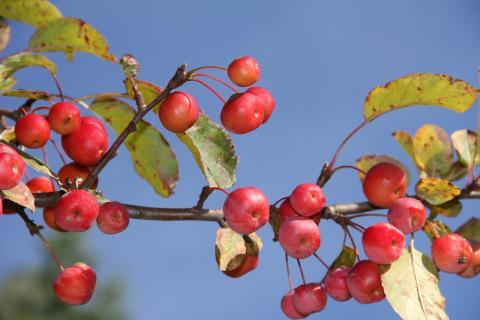
As winter nears, our feathered friends can have trouble finding as much food as they do in summer. Fall is the perfect time to make sure your garden is an inviting space for birds throughout the colder months.
One surefire way to get your yard noticed by birds is to grow plants that feature berries. Birds love to eat berries, and when they see these tasty fruits covering your yard they’ll make sure to stop for a snack. By planting a few of these berry bushes, you can ensure that your garden has plenty of plants that feed birds all winter long.
Here are some of the best berry plants for your garden. Since native plants are always a good choice, read through the list, then visit your local nursery to see which ones will work best in your climate!
Crabapple
There are many varieties of crabapple, so you can find one with the size and shape that fits your space. The little fruits start off hard but soften throughout the season until they’re perfect for birds. After providing food for our flying friends all season, the plants will bloom in shades of white, pink, or red. Just steer clear of Adams, Red Jewel, and Donald Wayman varieties—birds don’t seem to like these as much.
Hawthorn
In addition to being a wonderful medicinal herb for us humans, hawthorn grows bright red berries nearly all winter long. Birds will also seek cover in the bushes, although long thorns can make them uncomfortable (look for thornless varieties like cockspur). If your green thumb is struggling or your soil is less than fertile, you’re in luck—hawthorns are drought-tolerant and survive in most kinds of soil.
Beautyberry
Beautyberry is so easy to grow that you might find volunteers popping up once birds start feasting from your bushes and spreading seeds around. The berries grow in pretty, vibrant clusters in shades of purple, pink, or white. Birds like towhees, mockingbirds, and robins will all enjoy the fruits. Bonus? The berries can be used to make your own bug spray!
Chokeberry
Chokeberry plants won’t be a bird’s first choice—but once the higher fat foods are gone, they’ll feast on these red or black berries that are easy to grow. The chokeberry bush loves bright sunlight and will look beautiful in a fall garden. The berries are full of antioxidants and healthy for humans, but they’re not the sweetest berry on this list and are best eaten at peak ripeness.
Serviceberry
Cedar waxwings love serviceberries, but they’re not the only bird who will enjoy these light colored fruits. Serviceberry can grow as a tree, too, and it’s a great plant to feature in your garden because it puts on a show year round…spring blooms, fall fruits, vibrant leaves…and more! The blooms resemble apple blooms, and the loose foliage make it a good backdrop for smaller, shade-loving plants who can enjoy its dappled shade.
Elderberry
These dark purple berries start blooming in late summer and they attract butterflies in addition to robins, bluebirds, and other songbirds. Elderberry plants enjoy full sun or partial shade. Elderberries are also a popular food and medicine for humans, so you might want to harvest some yourself before the birds and other critters get them!
Huckleberry
Huckleberry plants feature pale flowers in the spring that hummingbirds will enjoy and small purple berries later in the year that other birds—as well as humans—will enjoy. If you live in a rural area, you might find other animals enjoying the huckleberries, too…even black bears have been known to feast on the berries.








